Exogenous enzymes are widely used, with basic purposes like:
Currently , the use of phytases and carbohydrases covers practically all monogastric feed in intensive farms.

Enzyme research
1876 . The history of enzyme research is closely linked to the history of biochemistry, the first time the term “enzyme” (from the Greek yeast) was used was in 1876 and it is attributed to the German physiologist Wilhelm Fiedrich Kühne.
1860 . Louis Pasteur concluded in his work, that fermentation is catalyzed by enzymes.
1926 . The first enzyme, cannavalia enzyformis bean urease, is crystallized.
1930 . The prolific author of the theory of the origin of life together with Oparin, John Burdon Sanderson Haldane in his treatise “Enzymes” wrote: “Interactions by weak bonds, between the enzyme and its substrate, could be catalysts of a reaction” this idea is the center of our current knowledge about the action mechanisms of enzymes.
Enzyme use in ruminants
Regarding the use of enzymes in ruminants, in 1960 Wise Burroughs’ team at “Iowa State University”, published the use of an enzyme conjugate belonging to MSD (Merck, Sharp & Dohme) Agro-Zyme in calf diets.
Already in this first article on the use of enzymes in ruminant diets, there are interesting results:
Some of the reasons that justify the use of enzymes in ruminants are:
1) the digestibility of organic matter in ruminants rarely exceeds 90%
2) more and more agroindustrial by-products of low quality are commonly used
3) the faster availability of carbohydrates which normally stimulates microbial population growth
4) the presence of different sized polysaccharides can have a prebiotic effect
5) the use of exogenous enzymes can cause effects of multifactorial origin. In summary, what is sought in an enzyme is that it improves the use of nutrients or that it can change the site where nutrients are broken down and used by the animal.
At a first glance and in a simplistic manner it seems clear that exogenous enzymes should be used in ruminants since they increase the use of fibrous parts and ruminal utilization.
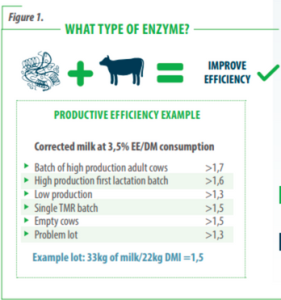
In an interview granted to Galician media the Director of Agriculture and Natural Resources of the University of South Dakota (USA) Alvaro García indicated: “The digestibility of forage fiber determines the profitability of livestock.” There are several alternatives to achieve this:
1) Selection of grains and forages of higher nutritional value
2) Improve the degradation capacity of the rumen microbiota
3) Use of additives that modify the pattern of rumen fermentation
4) Development of more efficient feeding practices
5) The use of unconventional foods
6) Use of chemical or biological treatments in fodder,
7) Use of exogenous enzymes to increase the digestibility of cell walls and/or starch (Rojo-Rubio et al. 2007).
In ruminants, the enzymes used must have the characteristics of any such product being marketed as:
Once it was clear that the use of enzymes in ruminants can be economically attractive, it was necessary to determine on which part of the diet was it most suitable to use these compounds and in which portion of the gastrointestinal tract must they make their effect….
[register]
Fibrolytic enzymes
Already from the first trial carried out in 1960, a fibrolytic enzyme that acted in the rumen was used.(Figure 2)
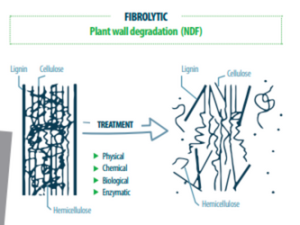
Figure 2. Fiber degradation
As there were still no products designed specifically for ruminants, enzymes designed for other industries such as paper, textiles, fuels and even fine chemistry began to be used. Although the most commonly used, are those aimed at improving silage.
Products that still retain their enzymatic activity in a residual way are also marketed. In these cases the commercial product also contains the medium, metabolites and fermentation products.
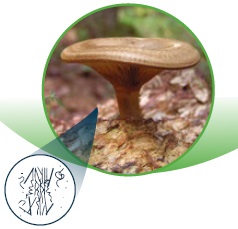 Lignolytic enzymes are obtained from basidiomycetes (fungi). A wood fungi that oxidizes both phenolic and non-phenolic compounds. Tests have been carried out in lambs with these types of enzymes at an increasing dose. Obtaining increases in ingestion and digestibility. The latter had a quadratic effect in the diet which is difficult to explain.
Lignolytic enzymes are obtained from basidiomycetes (fungi). A wood fungi that oxidizes both phenolic and non-phenolic compounds. Tests have been carried out in lambs with these types of enzymes at an increasing dose. Obtaining increases in ingestion and digestibility. The latter had a quadratic effect in the diet which is difficult to explain.
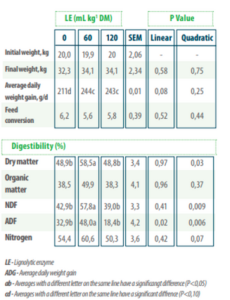
Table 1. Lignolytic enzymes- Performance of lambs consuming a high
forage diet including increasing enzyme doses
Fibrolytic enzymes, in general, should increase:
However they also :
Alpha-amylase enzymes
Alpha-amylase enzymes for dairy cow feeding are a radical innovation in dairy cattle nutrition. They can especially be used as a new approach to maximize starch use and fiber digestion (Figure 4).
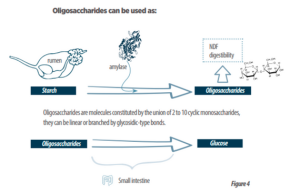
Oligosaccharides can be used as an energy source through fibrolytic bacteria
Fiber digestion time can be reduced when fibrolytic microorganisms have more available energy.
It has been shown that they practically double the rumen degradation rate of starch and fiber (NDF). Therefore, organic matter increases activity in the rumen, which means an overall improvement in the total digestibility of the ration (Figure 5).
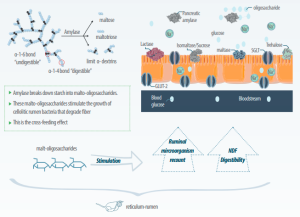
Figure 5. Definition of amylase activity
The results obtained suggest that the release of starch energy provides more energy to cows and increases the digestion of forages.
As a result, cows are able to make a more efficient use of the total ration. Which as a result optimizes feed costs, milk production yields, efficiency and quality. (Figure 6).
Results
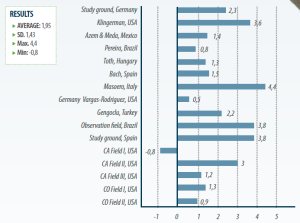
Figure 6. Meta-analysis of 16 tests in different countries with the incorporation of α-amylase
Bibliography available upon request to the author
[/register]